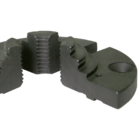Since learning that brass can be turned on a wood lathe (e.g. turning brass nuts for ferrules), I've been contemplating drilling and turning some brass rod to make an interchangeable tool holder for a custom handle, similar to how D-Way's and other such handles work. But I've hit a snag: I'm finding it difficult to get solid workholding on brass round bar (1.25" in the current instance). As in, obviously insecure, not safe to turn the lathe on. I have a fair range of jaws and nothing's even really close. I was hoping that Vicmarc's 35mm pin jaws would work but they deflect quite a lot, leaving a very poor grip.
So my question: does anyone have any good ideas for how to chuck up round metal bar for a project like this? I'd be happy to use a metal lathe chuck, but I have limited experience with metal lathes and I'm having difficulty finding out how/whether I can use or adapt those chucks for my lathe (1-1/4 x 8 TPI headstock w/ the usual 2MT bore). Any pointers would be greatly appreciated!
For clarity, here's my current (rather tentative) workflow:
So my question: does anyone have any good ideas for how to chuck up round metal bar for a project like this? I'd be happy to use a metal lathe chuck, but I have limited experience with metal lathes and I'm having difficulty finding out how/whether I can use or adapt those chucks for my lathe (1-1/4 x 8 TPI headstock w/ the usual 2MT bore). Any pointers would be greatly appreciated!
For clarity, here's my current (rather tentative) workflow:
- Rough cut the brass rod to my target length plus chucking length using a hacksaw (or perhaps I'll make a bar cutting jig for use with a jigsaw and metal cutting blade)
- Drill out the central bore with a bit modified to zero rake for brass cutting. Could use drill press or lathe.
- Drill the tap-dimensioned holes for two set screws (A letter 'F' bit for 5/16-18 threads)
- Tap the set screw holes
- Put it on the lathe between chuck and cone center on the tailstock
- Turn a tenon for mounting in the handle and shape the visible part of the holder
- Sand, polish, etc. on the lathe
- Part off, or dismount and cut
- Make handle and mount the holder

